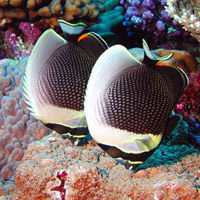 |
Palmyra Atoll Research Consortium
The Palmyra Atoll Research Consortium (PARC) is a partnership of research, conservation, and education institutions that conduct interdisciplinary work on the natural systems of Palmyra Atoll and the Central Pacific. As a founding member of the consortium, the Academy works together with partner institutions such as Stanford University, Scripps Institution of Oceanography, the American Museum of Natural History, the University of California at Santa Barbara, University of California at Irvine, University of Hawaii, the U.S. Geological Survey, and Victoria University of Wellington, New Zealand to understand terrestrial, marine, and climate systems of the atoll at various scales.
In 2007, CBRI Director and Chair of the Palmyra Atoll Research Consortium Science Committee, Dr. Healy Hamilton went to the remote field station on Palmyra to study octopuses with collaborator Dr. Christine Huffard of the Monterey Bay Aquarium Research Institute. Together with a team of Academy scientists and colleagues, Hamilton collected specimens and other information that will be critical to understanding how coral reefs are connected across oceans. PARC research combined with public education programs can help to form strategies to protect marine biodiversity.
|

